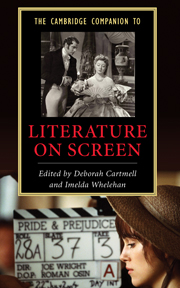Book contents
- Frontmatter
- Introduction - Literature on screen: a synoptic view
- Part One Theories of Literature on Screen
- Part Two History and Contexts
- Part Three Genre, Industry, Taste
- 8 Heritage and literature on screen: Heimat and heritage
- 9 “Don’t let’s ask for the moon!”: reading and viewing the woman’s film
- 10 Post-classical fantasy cinema: The Lord of the Rings
- 11 Adapting children's literature
- 12 Literature on the small screen: television adaptations
- Part Four Beyond the "Literary"
- Further reading
- Index
- Series List
12 - Literature on the small screen: television adaptations
from Part Three - Genre, Industry, Taste
Published online by Cambridge University Press: 28 September 2007
- Frontmatter
- Introduction - Literature on screen: a synoptic view
- Part One Theories of Literature on Screen
- Part Two History and Contexts
- Part Three Genre, Industry, Taste
- 8 Heritage and literature on screen: Heimat and heritage
- 9 “Don’t let’s ask for the moon!”: reading and viewing the woman’s film
- 10 Post-classical fantasy cinema: The Lord of the Rings
- 11 Adapting children's literature
- 12 Literature on the small screen: television adaptations
- Part Four Beyond the "Literary"
- Further reading
- Index
- Series List
Summary
Practices, perceptions, and prejudices: film versus television adaptations
Since the birth of cinema, filmmakers have adapted an eclectic range of sources, including many and varied sub-genres of literature - from classic eighteenth and nineteenth-century novels to “pulp” fiction, from thrillers to romances, from melodramas to ghost stories. The breadth and variety of film adaptations is clearly visible to most cinema-goers. When one speaks of television adaptations, in comparison, one tends to refer more particularly to prolific “classic serials”: relatively faithful adaptations of classic, mostly nineteenth-century, works of literature. So-called classic serials have formed a flourishing and prominent genre on television since the earliest days of broadcasting, and have constituted a significant portion of television's dramatic output.
Television adaptations of classic novels are comparatively more prominent than adaptations of other kinds of sources, not necessarily because they outnumber them, but for two powerful reasons. First, they are more frequently advertised as adaptations, rather than being subsumed into other generic categories - compare The Mayor of Casterbridge (1978), Middlemarch (1994), and Pride and Prejudice (1995) which are clearly marked as classic-novel adaptations, with series such as Miss Marple (1985-1992), Inspector Morse (1987-2000), and The Ruth Rendell Mysteries (1987-2000), which are regarded primarily as detective serials, and only secondarily (if at all) as adaptations. Second, classic-novel adaptations share a generic identity: they “look” similar to one another (or so it is claimed), so that their visibility is heightened, along with their tendency to be categorized straightforwardly as adaptations.
- Type
- Chapter
- Information
- The Cambridge Companion to Literature on Screen , pp. 181 - 196Publisher: Cambridge University PressPrint publication year: 2007
- 15
- Cited by

